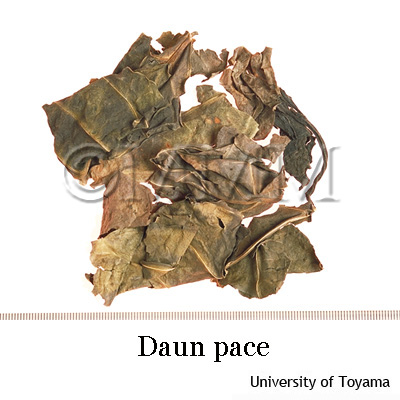Crude drug sample data base
※Click on the image to enlarge it.
Scientific information data base
| Crude drug name | Indonesian name, English name | Daun pace, Noni | ||
|---|---|---|---|---|
| crude drug image |
| |||
| Original plant name | Morinda citrifolia Linn. | |||
| Family name | Rubiaceae | |||
| Used part | Leaves, fruits | |||
| Distribution area | Indigenous in tropical Asia and tropical Australia, it occurs throughout Indonesia. It grows wild along the coast. In Java it is cultivated in mountainous areas in every villages [201, 221]. | |||
| Description | Leaves simple, large, decussate and stipulate. Blade broadly elliptic to obovate, shiny, soft and fleshy, with 5-8 pairs of secondary and inconspicuous tertiary nerves. Petiole long. The plant is a shrub or small tree up to 8(-12)m tall; greyish-brown shallowly fissured bark with yellowish-red inner bark. Flowers white, characteristically fused into a pedicelled and solitary fleshy, mulberry-shaped. The fruit is a light, greyish-green fleshy smelly syncarp, yellowish upon ripening [221, 228]. | |||
| Drug effect | Pungent, sweet, warming [231]. | |||
| Specific actions | Hypotensive, anthelmintic, emenagogue [231]. | |||
| Frequency in use | Abundant. | |||
| Common uses | The red dye from the root bark formerly played an important role in batik dyeing in Indonesia. The fruit smells like a putrid cheese when ripe and is eaten raw or prepared. The fruit pulp is used to cleanse hair. Young leaves are eaten as vegetables. The fruit extract is manufactured and sold in pharmacies [201, 221]. | |||
| Side effect | A man with chronic renal insufficiency developed a hyperkalaemia after drinking the juice of Morinda citrifolia Linn. The potassium concentration in the juice samples is 56.3 mEq/l [228]. | |||
| Pharmacological effect | Alcoholic extract of leaves showed good in-vitro anthelmintic activity against human Ascaris lumbricoides [221]. Citrifolinoside, an iridoid glycoside isolated from the leaves exhibited significant inhibition of activator protein-1 in cell cultures [221]. Aqueous and ethanolic extracts of the roots lowered blood pressure in rabbits and cats [221]. An aqueous ethanol extract of the dried fruits showed histaminergic effect on smooth muscles in guinea pigs [221]. The fruit juice contains a polysaccharide-rich substance which displays anti tumour activity in mice and also stimulated interferon induction. The prevention of carcinogen-DNA adduct formation and the antioxidant activity may contribute to the cancer preventive effect [221]. Damnacanthal isolated from the root showed potent inhibitory activity towards tyrosine kinases [221]. A lyophilised aqueous extract of roots of Morinda citrifolia L. exhibits a dose-dependent central analgesic property in the writhing and hotplate tests [228]. An immunomodulatory polysaccharide-rich substance from the fruit juice of Morinda citrifolia has been found to possess prophylactic and therapeutic potentials against the immunomodulator sensitive Sarcoma 180 tumour system [PMID:14669249]. The effects of juice from Morinda citrifolia on gastric emptying, gastrointestinal transit, and plasma level of cholecystokinin in rats were studied. These results suggest that oral application of the juice inhibits gastric emptying in male rats via a mechanism involving stimulation of cholecystokinin secretion and cholecystokinin 1 receptor activation [PMID:15803749]. | |||
| Medical system | Indonesian medicine (Jamu) | |||
| Traditional usage | Leaves are used to treat stomach disorders, irregular menstruation, diabetes. Leaves are smeared with oil, heat and apply on the abdomen or back to treat stomach cramp, cold, and cramp after parturition. It is also applied on the back and loins to reduce pain sensation due to dysentery or other diseases. It is also used as a vermifuge and is applied topically to treat cough. The fruit is eaten to treat diabetes, beri-beri, asthma, cough and other respiratory problems, and as an emmenagogue. Fruit juice is taken to treat difficulty in urination, liver problems, and cough.The fruit extract is manufactured and sold in pharmacies. The decoction of fruit, bark and root are used to cleanse wounds [201, 221]. | |||
| Formulation | 1) Hypertension: 3 grated fruit are steeped in 100ml of boiled water and drink 100 ml of the tea a day for 7 consecutive days [231]. 2) Mouth ulcer: 1 grated fruit mixed with 2 slices of ''batu banana'' fruits (local banana fruits) are boiled in 110 ml of water to make a decoction. Drink 100 ml of the decoction once a day for 7 days [231]. | |||
| References | Reference book Tips! | [201] K. Heyne, Tumbuhan Berguna Indonesia, Vols. 1-4, 1987. Diedarkan Oleh Koperasi Karyawan Departemen Kehutanan, Jakarta, Indonesia. Vol. 3, pp 1795-179. [207] Badan Penelitian Dan Pengembangan Kesehatan and Departemen Kesehatan, Kesejahteraan Sosial Ri. Vols. 1-5, Inventaris Tanaman Obat Indonesia, Jakarta, Indonesia. Vol. 1, Part 1 (2000), pp 159-160. [221] Lemmens, R.H.M.J. and Bunyapraphatsara, N. (editors): Plant Resources of South-East Asia No, 12 (3). Medicinal and poisonous plants 3. Prosea Foundation, Bogor, Indonesia. 2003. pp 302-304. [228] Christophe, Wiart.: Medicinal Plants of Southeast Asia. Prentice Hall. Malaysia. 2002. pp 292-293. [231] Soedibyo, Mooryati: Alam Sumber Kesehatan: Manfaat dan Kegunaan (Natural resources for health. Benefits and uses). Balai Pustaka. 1998. pp 260-261. | ||
| Research paper | 1. Pu HF, Huang WJ, Tseng WM, Wang SW, Liu YW, Doong ML, Wang PS. Effects of juice from Morinda citrifolia (Noni) on gastric emptying in male rats. Chin J Physiol. 231;47(4):169-74, 2004. (PMID: 15803749) 2. Furusawa E, Hirazumi A, Story S, Jensen J. Antitumour potential of a polysaccharide-rich substance from the fruit juice of Morinda citrifolia (Noni) on sarcoma 180 ascites tumour in mice. Phytother Res. 17(10):1158-64, 2003. (PMID: 14669249) | |||
| Remarks | [DNA sequences] HM246519, AY762836, AY762843 In recent years, the fruits have been recommended for treatment of diabetes, high blood pressure and cancer and therefore more research is needed to confirm its applications [221]. | |||
| Last renewal date | 2024/03/04 | |||



